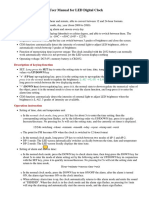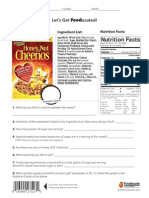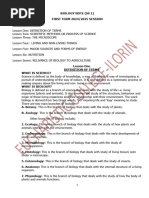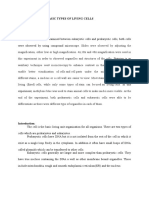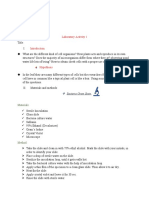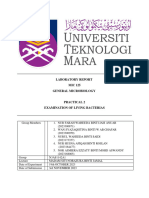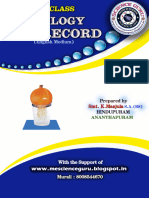2 ND
Uploaded by
Geofrey Jinv2 ND
Uploaded by
Geofrey JinvName: Geofrey Jinuin Class: 3 Melati
Peka Science (2)
Activity : To observe the different type of unicellular microorganism
Apparatus :Microscope, glass slide, cover slip, needle, dropper, filter paper, pond water, yeas
solution.
Instructions.
1. Using a dropper, place a drop of pond water on a glass slide and cover it with a cover slip.
2. Examine the slide under the microscope using high power lens
3. Identify and dray the microorganisms that can be seen.
4. Mount a drop yeast solution on a glass slide and examine under the microscope with a high power lens.
5. Draw the yeast cells observed.
Procedure.
1. Using a dropper, place a drop of pond water on a glass slide and cover it with a cover slip.
2. The slide was Examine under the microscope using high power lens.
3. The micro organisms that can be seen has been identify and draw.
4. Mount a drop yeast solution on a glass slide and examine under the microscope with a high power lens.
5. The yeast cells observed and has been draw.
Observations:
Discussion.
1.Give the meaning of the following terms.
a) Microorganisms: An organisms which is to tiny to be seen by the naked eye
b) Unicellular Organisms: Organisms that consist only one cell.
2.What can you deduce from your observations about the size and shape of the organisms found in the pond
water?
-It’s size is very small and have many shape
3.Name the organisms which appear green in colour.
-Euglena
4.Classify the microorganisms into animal and plant cell.
Animal cell Plant cell
Paramecium Euglena
Amoeba Yeast
Conclusion:-Unicellular organisms are made up of one cell and they vary in Multi cellular organisms and micro
organisms.
You might also like
- The Essentials of Technical Communication (Elizabeth Tebeaux, Sam Dragga)100% (10)The Essentials of Technical Communication (Elizabeth Tebeaux, Sam Dragga)390 pages
- Codi Byte - Chat GPT Bible - 10 Books in 1_ Everything You Need to Know About AI and Its Applications to Improve Your Life, Boost Productivity, Earn Money, Advance Your Career, And Develop New Skills.92% (25)Codi Byte - Chat GPT Bible - 10 Books in 1_ Everything You Need to Know About AI and Its Applications to Improve Your Life, Boost Productivity, Earn Money, Advance Your Career, And Develop New Skills.447 pages
- Self-Guided EMDR Therapy Workbook Healing From Anxiety, Anger, Stress, Depression, PTSD Emotional Trauma (Katherine Andler)100% (16)Self-Guided EMDR Therapy Workbook Healing From Anxiety, Anger, Stress, Depression, PTSD Emotional Trauma (Katherine Andler)54 pages
- Case Study 1.2 The Hokies Lunch Group - Edited67% (9)Case Study 1.2 The Hokies Lunch Group - Edited4 pages
- Dokumen - Pub - The Last Law of Attraction Book Youll Ever Need To Read The Missing Key To Finally Tapping Into The Universe and Manifesting Your Desires Paperbacknbsped 1701069288 978170106928294% (32)Dokumen - Pub - The Last Law of Attraction Book Youll Ever Need To Read The Missing Key To Finally Tapping Into The Universe and Manifesting Your Desires Paperbacknbsped 1701069288 9781701069282193 pages
- Mantak Chia - Awaken Healing Energy Through The Tao100% (77)Mantak Chia - Awaken Healing Energy Through The Tao195 pages
- Building Better Habits With The Habit Loop: 1. CUE 2. Craving91% (64)Building Better Habits With The Habit Loop: 1. CUE 2. Craving1 page
- Textbook of Modern Herbology Second Revised Edition100% (14)Textbook of Modern Herbology Second Revised Edition399 pages
- Foxfire 5 Ironmaking, Blacksmithing, Flintlock Rifles, - Wigginton100% (10)Foxfire 5 Ironmaking, Blacksmithing, Flintlock Rifles, - Wigginton516 pages
- P 87-102 QTR 2 Module 2 Plant and Animal CellsNo ratings yetP 87-102 QTR 2 Module 2 Plant and Animal Cells17 pages
- Module 1: Introduction To Microbiology & Microorganism Brief History of MicrobiologyNo ratings yetModule 1: Introduction To Microbiology & Microorganism Brief History of Microbiology4 pages
- Score A Programme Science - Form 1: Understanding CellsNo ratings yetScore A Programme Science - Form 1: Understanding Cells21 pages
- Pmr Science Form 1 Chapter 2 Cell as a Unit of Life 2No ratings yetPmr Science Form 1 Chapter 2 Cell as a Unit of Life 28 pages
- Science - Form 1 Cell As A Unit of LifeNo ratings yetScience - Form 1 Cell As A Unit of Life23 pages
- Lab 1 Culture Microorganism by Hay Infusion - forBSEd III-P PDF100% (2)Lab 1 Culture Microorganism by Hay Infusion - forBSEd III-P PDF2 pages
- Hay I Can Grow OneCelled Organisms Lesson PlanNo ratings yetHay I Can Grow OneCelled Organisms Lesson Plan3 pages
- paractical manual of cell bio 201 25-4-17No ratings yetparactical manual of cell bio 201 25-4-1724 pages
- Lab 2 Observation of Simple MicroorganismsNo ratings yetLab 2 Observation of Simple Microorganisms3 pages
- Science 6 (Science Schoolbook For Grade 6 Students) - Le Loi School (2021)No ratings yetScience 6 (Science Schoolbook For Grade 6 Students) - Le Loi School (2021)64 pages
- Unit: Cell Structure and Function: Science 10No ratings yetUnit: Cell Structure and Function: Science 108 pages
- Fundamentals of Microbiome Science: How Microbes Shape Animal BiologyFrom EverandFundamentals of Microbiome Science: How Microbes Shape Animal Biology3/5 (2)
- Plant Healer 2020 Herbal Education Guide & Schools Directory100% (2)Plant Healer 2020 Herbal Education Guide & Schools Directory81 pages
- Beginning Singing by John Henny Download VersionNo ratings yetBeginning Singing by John Henny Download Version130 pages
- (Ebook) The Neuroscience of Human Relationships: Attachment and the Developing Social Brain (Second Edition) (Norton Series on Interpersonal Neurobiology) by Louis Cozolino ISBN 9780393707823, 0393707822 - Download the ebook with all fully detailed chapters100% (1)(Ebook) The Neuroscience of Human Relationships: Attachment and the Developing Social Brain (Second Edition) (Norton Series on Interpersonal Neurobiology) by Louis Cozolino ISBN 9780393707823, 0393707822 - Download the ebook with all fully detailed chapters50 pages
- Blood Basics: 1. What Makes Up The Blood in Our Bodies?No ratings yetBlood Basics: 1. What Makes Up The Blood in Our Bodies?2 pages
- In Vitro Vascular Permeability Imaging Assay: (Green)No ratings yetIn Vitro Vascular Permeability Imaging Assay: (Green)16 pages
- Art As Scientific Exploration Why How Do Bees Make HoneyNo ratings yetArt As Scientific Exploration Why How Do Bees Make Honey2 pages
- Problems and Prospects of Genetically Modified Organisms in Agricultural ProductionNo ratings yetProblems and Prospects of Genetically Modified Organisms in Agricultural Production36 pages
- Get Metabolomics Paul L. Wood free all chapters100% (15)Get Metabolomics Paul L. Wood free all chapters55 pages
- Download Deer The Animal Answer Guide 1st Edition George A. Feldhamer ebook All Chapters PDF100% (3)Download Deer The Animal Answer Guide 1st Edition George A. Feldhamer ebook All Chapters PDF81 pages
- Evolution PYQ (2) - 19189644 - 2023 - 06 - 05 - 12 - 38No ratings yetEvolution PYQ (2) - 19189644 - 2023 - 06 - 05 - 12 - 3817 pages
- 135150-mark-scheme-unit-f215-control-genomes-and-environment-juneNo ratings yet135150-mark-scheme-unit-f215-control-genomes-and-environment-june21 pages
- Metabolic Fate of C-Skeleton of Glucogenic Amino AcidsNo ratings yetMetabolic Fate of C-Skeleton of Glucogenic Amino Acids11 pages
- Biol 216 2020 Topic 3 Cell Determination and Stem Cells - Powerpoint 3.0 Cloning and ESCs - TaggedNo ratings yetBiol 216 2020 Topic 3 Cell Determination and Stem Cells - Powerpoint 3.0 Cloning and ESCs - Tagged25 pages
- Pediatric Diabetes - 2020 - Gopi - Genotype Phenotype Correlation of KATP Channel Gene Defects Causing Permanent NeonatalNo ratings yetPediatric Diabetes - 2020 - Gopi - Genotype Phenotype Correlation of KATP Channel Gene Defects Causing Permanent Neonatal11 pages
- 9th Class Biology Guess Paper 2024 For All Punjab Boards - Zahid NotesNo ratings yet9th Class Biology Guess Paper 2024 For All Punjab Boards - Zahid Notes14 pages



